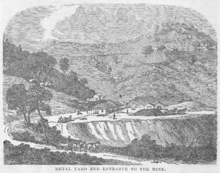Hutchings' Illustrated California Magazine

Hutchings' Illustrated California Magazine was a magazine published between 1856 and 1861, in San Francisco, which played an important role in popularizing California in general, and to a large extent Yosemite National Park in particular.
Publisher and promoter James Hutchings was born in Towcester, England, and in 1848 came to the United States along with a vast wave of Europeans that were escaping a maelstrom of economic, political and religious oppression in the late 1840s. Shortly after he arrived gold was found in the Sierra Nevada, and Hutchings decided to seek his fortune. His was a common story insofar as he did not make a good living mining gold, but what little he did make he invested. In addition to attracting settlers to the west coast, the gold rush also brought technology, in particular printing presses, and Hutchings learned to make a moderately lucrative living publishing and selling letter sheets, which were printed broad sheets purposely left blank on the back so they could be used to write letters, something akin to large-format postcards. They became very popular among miners, who used them when they wrote home to friends and relatives in the east. Aside from making a living selling the letter sheets, as Hutchings traveled around California he gained a sense of what was important in the popular mind and came up with the idea of an illustrated magazine.
The news of the Mariposa Battalion's incursion into a valley (that the battalion members named Yosemite) for the purpose of tracking down alleged renegade Indians was fairly widely published, but the news focused on the confrontation. Hutchings was one of the few people to note the mention of a 1000 foot waterfall, and in 1854 when he was first formulating the idea of his illustrated magazine, he decided that a trip into that valley might make for interesting stories in the inaugural issue of the magazine. In the late spring of 1855 he hired artists to join him, and when the party arrived in the foothills he hired two Mi-Wuk men as guides. As the party came around Inspiration Point, they stopped long enough for Thomas Ayres to get a detailed sketch, which was published as a lithographic poster that fall, the first published image of Yosemite Valley. In June 1856, the entire account was published in Volume I of the magazine, and included five of Ayres' drawings.
The magazine was published monthly from July 1856 to June 1861, five volumes total. Although Yosemite was prominent, it was a magazine of general interest that focused on California's nascent tourist attractions. Each issue contained travel narratives, ranging from simple day trips out of San Francisco to arduous trans-Sierra treks. Longer articles were interspersed with shorter and lighter pieces, such as poetry and tables of interesting facts. The magazine popularized a number of well-known legendary stories of the West including the Pony Express, Grizzly Adams and Snowshoe Thompson. The story of the naming of Yosemite was first published in the magazine in an article by Lafayette Bunnell.
References
- Huntley, Jen A. (2011). The Making of Yosemite: James Mason Hutchings and the Origin of America's Most Popular National Park. Lawrence: University Press of Kansas. ISBN 978-0-7006-1805-7. Retrieved November 29, 2013.
Links to magazine archives
The following are links to issues of the magazine on the Internet Archive. Direct links to representative articles are also provided. Note that page numbering continues between issues; for example, the first page of the August 1856 issue is page 49.
- Hutchings, James M., ed. (July 1856 – June 1857). Hutchings' Illustrated California Magazine. Vol. I. San Francisco: Hutchings & Rosenfield. Retrieved November 30, 2013.
- Noteworthy articles:
- "Our Introductory" The introductory story on the journey to Yosemite (July 1856, pp. 1-8).
- "The Quicksilver Mine of New Almaden" Early history of mercury mining near San Jose, including travel narrative of stage coach ride down the peninsula. (September 1856, pp. 97-105).
- "Packing in the Mountains" Details about the mule packing industry which supplied the mining camps (December 1856, pp. 241-248).
- Hutchings, James M., ed. (July 1857 – June 1858). Hutchings' Illustrated California Magazine. Vol. II. San Francisco: Hutchings & Rosenfield. Retrieved November 30, 2013.
- Noteworthy articles:
- "Mining For Gold In California" Illustrated and detailed explanation of several gold mining methods (July 1857, pp. 2-14).
- "The History of a Letter" Illustrated and detailed explanation of early California mail delivery (January 1858, pp. 289-300).
- Hutchings, James M., ed. (July 1858 – June 1859). Hutchings' Illustrated California Magazine. Vol. III. San Francisco: Hutchings & Rosenfield. Retrieved November 30, 2013.
- Noteworthy articles:
- "Scenes In the Valleys and Mountains of California" Illustrated and detailed description of many early California interior towns (May 1859, pp. 481-493).
- "How the Yo-Semite Valley Was Discovered and Named" First written account of the origin of the name, by Lafayette Bunnell (May 1859, pp. 498-504).
- Hutchings, James M., ed. (July 1859 – June 1860). Hutchings' Illustrated California Magazine. Vol. IV. San Francisco: Hutchings & Rosenfield. Retrieved November 30, 2013.
- Noteworthy articles:
- "Notes and sketches of the Washoe Country" Illustrated account of early mining settlements in Nevada, then still part of Utah Territory (April 1860, pp. 433-440).
- Hutchings, James M., ed. (July 1856 – June 1857). Hutchings' Illustrated California Magazine. Vol. V. San Francisco: Hutchings & Rosenfield. Retrieved November 30, 2013.
- Noteworthy articles:
- "The Pony Express" An early popularization of this transcontinental mail route. (July 1860, pp. 1-7).
- "Adventures of James Capen Adams, Mountaineer and Grizzly Bear Hunter, Of California" Possibly the first published popularization of Grizzly Adams. (September 1860, pp. 103-114).